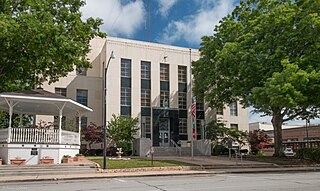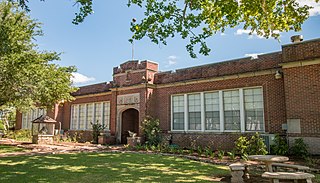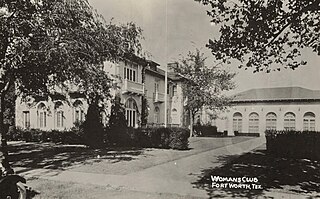
Washington County is a county in Texas. As of the 2020 census, the population was 35,805. Its county seat is Brenham, which is located along U.S. Highway 290, 72 miles northwest of Houston. The county was created in 1835 as a municipality of Mexico and organized as a county in 1837. It is named for George Washington, the first president of the United States.

Chappell Hill is an unincorporated community in the eastern portion of Washington County, Texas, United States. It is located inside Stephen F. Austin's original colony, and the land is some of the oldest Anglo-settled in the state. According to the Handbook of Texas, the community had a population of 600 in 2000. It is located within the Greater Houston metropolitan area.

Thurber is an unincorporated community in Erath County, Texas, United States, located 75 miles west of Fort Worth. It was, between 1888 and 1921, one of the largest producers of bituminous coal in Texas and the largest company town in the state, with a population of over 10,000. The population of the community is 48 per the 2010 United States Census.

Pettit Memorial Chapel or Pettit Chapel was designed by architect Frank Lloyd Wright and constructed in 1907. The Pettit Chapel is located in the Belvidere Cemetery in Belvidere, Illinois, United States, which is in Boone County. The cemetery was chartered in 1837 and contains 13,000 known graves. The chapel was listed on the U.S. National Register of Historic Places December 1, 1978. The Pettit Chapel is an example of Frank Lloyd Wright's famed Prairie Style. It is the only funerary structure designed by Wright to be built in his lifetime.

The Southgate–Lewis House is located one mile east of the Texas State Capitol in Austin, Texas, at 1501 East 12th Street. The house was constructed in 1888, and now stands as an African-American historical landmark. It is also a repository for African-American History and Culture in the region of east Austin, which historically became an African-American neighborhood. The City of Austin has now declared this region to be "Austin's Black Cultural District." The Southgate–Lewis House is located in the center of the "African American Cultural Heritage District".
Harriet Francoeur Nevins was an American philanthropist and animal welfare advocate born in Roxbury, Massachusetts. Widow of David Nevins Jr., she used her inheritance to leave a legacy to the people of the Bay State. She died November 14, 1929, at her home in Methuen, Massachusetts.

Soule University was a private Methodist university in Chappell Hill, a rural community in Washington County, Texas, United States. Chartered in 1856 and named after Bishop Joshua Soule, the school replaced the male department of Chappell Hill Male and Female Institute and was intended to succeed the struggling Rutersville College. Soule was beset by financial challenges after the American Civil War and two epidemics of yellow fever, leading the Methodist Church and Soule's president to form Southwestern University as a replacement in 1873. Despite the Texas Legislature transferring Soule's charter to Southwestern in 1875, local supporters kept Soule open until 1887 under the name Soule College.

The Stagecoach Inn of Chappell Hill is a historic stagecoach inn at Main and Chestnut Streets in Chappell Hill, Texas, United States.

Chappell Hill Public School is a historic school on Poplar Street in Chappell Hill, Texas. The old bell from Chappell Hill Female College, which was at this location until 1912, is preserved on the property.

The Dr. Archibald Neil Sinclair House on Puʻu Pueo overlooking Mānoa Valley and Diamond Head on the island of Oʻahu was built in 1917 in a Colonial Revival style designed by a leading local architectural firms, Emory and Webb, who also designed the Hawaii Theatre and other fine buildings on the island. The large, sloping property has two entrances: one below the front lawn at 2726 Hillside Ave., the other above the house at 2725 Terrace Dr., Honolulu, Hawaiʻi. It was listed in the National Register of Historic Places in 1983.

The Pioneer Memorial Library is located at 115 W. Main Street, Fredericksburg, Gillespie County, in the U.S. state of Texas. Designed by Alfred Giles, it was built in 1882 to replace the original 1855 courthouse, and was later superseded by the current 1939 courthouse designed by Edward Stein. The first floor houses the Children's Section, while the second floor houses the Adult Section, Texas Room, and newspapers and magazines. It is also called the McDermott Building because of the 1967 and 1984 restorations funded by Mr. & Mrs. Eugene McDermott. It was added to the National Register of Historic Places in 1971, and was designated a Recorded Texas Historic Landmark in 1967.

First Christian Church is a historic church at 612 Throckmorton Street in Fort Worth, Texas. It was founded in 1855, making it the oldest continuously operating church established in Fort Worth, Texas. The present building at 6th and Throckmorton dates back to 1915. It was designed by architects E.W. Van Slyke and Clyde Woodruff in a Renaissance Revival style. The raised two-story limestone building has a Greek Cross plan with a tower and copper-clad dome at the crossing and three porticos with Corinthian columns. The building was listed on the National Register of Historic Places in 1983 and received the Fort Worth Historical and Cultural Landmarks Designation in 2006.

The Smith County Historical Society, housed in the Carnegie Library, is located at 125 S. College Street in the city of Tyler, Smith County, Texas, U.S. It was built in 1904 as the Carnegie Public Library, and added to the National Register of Historic Places listings in Smith County, Texas in 1979. When Tyler built a new public library, the Carnegie building was leased to the Smith County Historical Society and continues to operate as a museum and archives.

The Cotton Belt Depot Museum is a museum located in the historic railroad depot in Tyler, Texas.

The Robert E. Howard Museum is located at the junction of Texas State Highway 36 and Avenue J in Cross Plains, in the county of Callahan, in the U.S. state of Texas. The museum was the family home of author Robert E. Howard, creator of Conan the Barbarian. The structure was added to the National Register of Historic Places listings in Callahan County, Texas in 1994.

The Bass Harbor Memorial Library is the public library of Tremont, Maine. It is located at 89 Bernard Road in the village of Bernard, in an historically significant Colonial Revival building built in 1922 with funds donated by Tremont native Rhoda M. Watson. The building was listed on the National Register of Historic Places in 2009.

J. R. Routt House is an historic dwelling of local significance in Chappell Hill, Texas, United States. It was added to the National Register of Historic Places on February 20, 1985.

Hopewell School, also known as the Hopewell-Rosenwald School, is a former African American school in Cedar Creek, Texas, that was listed on the National Register of Historic Places on July 15, 2015. The school was built in 1921–1922 with assistance from the Rosenwald Fund. The school opened in 1922 and closed in the late 1950s.
Chappell Hill Female College was a private college in Chappell Hill, a rural community in Washington County, Texas, United States. It was founded in 1850 as part of the coeducational school Chappell Hill Male and Female Institute. First chartered by the Texas Legislature in 1852 as a non-denominational preparatory school, the charter was amended to affiliate the school with the Methodist Church in 1854, and was rechartered as a women's college after the male department was spun off as Soule University in 1856. It was closed in 1912 and the building became a public school until a replacement was built in 1927 that preserves the college's bell. The site was added to the National Register of Historic Places in 1985.

The Woman's Club of Fort Worth is one of the city's oldest membership organizations, formed in 1923 by the members of several existing woman's clubs. The Woman's Club complex comprises eight historic buildings on Fort Worth's Near Southside and was listed on the National Register of Historic Places in 2017. As with many woman's clubs in the United States, the Woman's Club of Fort Worth has its roots in the Progressive Movement, with its original mission of "the cultural and civic advancement of Fort Worth; and the study of literature, history, science, painting, music, and other fine arts."



























